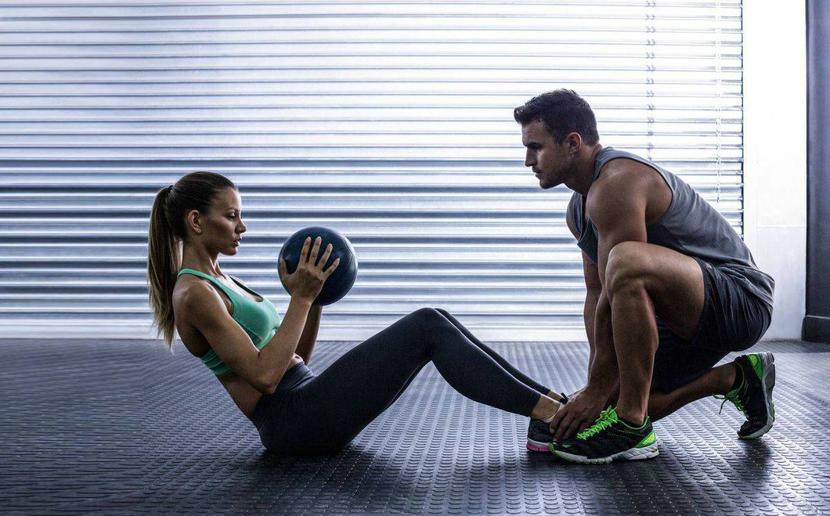
In this article you will learn:
- Why you can (with the right know-how) really train every day
- The numerous advantages of high-frequency training.
- How you can REALLY start high-frequency training (HFT) without overloading yourself
- Why squats are the perfect HFT exercise
- How you can get started with the HFT Challenge immediately and make fantastic progress
- For whom the HFT Challenge & high-frequency training are generally suitable or not suitable
“Muscles need at least 48 hours to regenerate”, you have probably heard the myth before. A statement that should never really represent a general rule, but was only intended as a guideline for absolute training beginners. The fact is:
The “optimal” regeneration time of the muscles depends on the intensity of the exercise, the exercise volume AND the ability of your body to regenerate.

This is the basis of high frequency training , the most effective form of training I know. Some may doubt this. High volume or high intensity are the form of training favored by fitness magazines and based on bodybuilding. Well, I like John Broz’s disarming counter-argument:
If your family was captured and you were told you needed to put 100 pounds onto your max squat within two months or your family would be executed, would you squat once per week? Something tells me that you’d start squatting every day.
This extreme split workout is an artificial breed of bodybuilding made for people who take steroids. Because they have to bombard every muscle with countless sentences because their muscle mass has long since exceeded the natural level.
Many people have this question on their lips and the only correct answer: Yes, that works!
It is time to overcome the doubts that bodybuilding magazines have planted about something that is intuitively obvious to everyone. Of course, that doesn’t mean you have to train every day. Those who cannot or do not want to do this in time are of course able to achieve excellent progress even with lower training frequencies.
However, if you have the opportunity and motivation to do strength training every day , then I advise you to take this chance. Because with the right method you can achieve fantastic results!
If you do it right, you can use high-frequency training:
- record incredible strength gains
- improve the body’s ability to regenerate
- build muscle quickly
- Burn body fat
- have more energy in everyday life
These advantages are closely related. So let me briefly explain the effect of high-frequency training in more detail.
Let’s start with Strength and muscle building : Strength gains in the body are achieved on the one hand by building muscles and on the other hand by optimizing coordination.
The more often you train, the better your body gets to know and coordinate the movements.
So you can develop more strength and thereby set better growth stimuli for the muscles .
The better the coordination of a movement, the more you force your body to build up muscles in order to meet the training stimuli.
This effect is reinforced by the fact that your body increasingly learns to regenerate faster. This means that in the future you will be able to train more often – without being overloaded.
This in turn also means that you can burn body fat more effectively because you use more energy.
High-frequency training provides the training framework to build muscle or burn fat. Whether you then build muscle or burn body fat, of course, also depends on your diet.

If you take in more calories than you burn, you are of course not losing body fat, that is very clear.
The last point: More energy.
This is of course partly due to the increased regeneration ability, but especially to the fact that the workouts with high frequency training look a little different than with volume or intensity training.
I have to explain this point a little more precisely, because it is the most common source of errors when entering high frequency training .
Experience has shown that many people believe that they could simply do the same workouts with high frequency training as before, just with a higher frequency. But of course that would almost certainly lead to overload and not produce the results you would normally expect.
Effective training is always based on designing frequency, volume and intensity so that the body is pushed to its limits but not overloaded.
So if you increase the frequency significantly, the volume and / or intensity must be reduced in return.
In high frequency training, therefore, intensity techniques are rarely used, if at all. There are also fewer exercises for individual muscles. With HFT according to Zippel, for example, only three basic exercises, which together effectively challenge the whole body, are performed per workout and optionally at the end of the workout with exercises for weak points.
I’ll introduce you to a damn good HFT entry-level plan in a moment. Before that I just want to finish the thought:
Because volume and intensity are a little lower and HFT is actually all about overloading the central nervous system not , the individual workouts are far less sore – that’s what you train for yes more often.
This means that after an HFT workout you don’t sneak through the alleys like a pile of misery, moan on every staircase and have sore muscles for days, but rather you are refreshed and full of energy.
This is actually one of the most important advantages for me, because from my point of view it simply equates to a higher quality of life. But that is something that everyone has to experience firsthand.
Since switching to high-frequency training is difficult, we limit ourselves to one exercise that is perfect for HFT: the squat.

Since squats use the tremendous power potential of the entire lower body and a large part of the body’s muscles , we get the best results with this one exercise.
Your squat training weights will go through the roof. In addition, all other parts of the body and exercises benefit enormously from performing squats with high frequency. That’s because squats have the biggest effects on the endocrine system.
This is the HFT squat challenge
- Do one training set of squats per day – EVERY day for 6 weeks!
- Start with a weight that you could about do 8 reps (or a little less) with.
- Do as many reps as you can in each training set – the set only ends when you really can’t manage a single rep (that’s crucial)!
- As soon as you have achieved 8 or more repetitions in a training set, the training weight will be increased by 5 kg for the next workout (i.e. the next day).
- Before each training set, do a few warm-up sets (4-5 are enough) in which you gradually increase the weight and approach the actual training weight.
- Always make sure that the technology is as clean as possible, to protect the CNS.
- Train your upper body in parallel, but not with high frequency (see next section).
I know that many are used to doing at least three sets per exercise. But that is not necessary here. It would be inefficient and, in many cases, even counterproductive. Believe me, a sentence is optimal in this case if you stick to it consistently for 6 weeks.
The upper body training in the Challenge
You can easily train your upper body the way you have done before. The heart of the matter are the squats. But if you don’t have an upper body routine or want “fresh blood”, you are welcome to use the upper body training program I developed especially for the challenge:
Workout A
Shoulder presses: 3 sets, 6-8 reps, 120 sec break in between
Pull-ups: 5 sets, as many repetitions as possible, with a break of 120 seconds in between
Dips: 2 sets, as many repetitions as possible, with a break of 120 seconds in between
Workout B
Superset A
3 sentences with a 90 second break in between
Barbell row: 6 reps
Body Rows: As many reps as possible
Superset B
3 sentences with a 90 second break in between
Bench press: 6 reps
Pushups: As many repetitions as possible
With a superset, the two exercises are completed one after the other and only then paused. So first bench press, then straight away as many push-ups as possible, then rest 90 seconds and finally two more such sets.
As an alternative to the body rows, you can also do one-armed dumbbell rows (8-12 reps per side).

Workout C
Shoulder power
5 sentences, 150 seconds break in between
Shoulder press: about 5 reps, choose a weight that you can do about as many reps in a set, and do as many reps as you can with that weight in each set
Push-Pull-Ladder
1 pull-up, 2 push-ups, 30 sec break, 2 pull-ups, 4 push-ups, 30 sec break, 3 pull-ups, 6 push-ups, 30 sec break, 4 pull-ups, 8 push-ups, 30 sec break, 5 pull-ups, 10 push-ups, 30 sec pause…. until you miss the required rep goal. Then pause another 30 seconds and then do as many pull-ups and as many push-ups as possible in the last set.
Training cycle
Take a full day of rest between upper body exercises .
A reasonable breakdown would be, for example: Monday – workout A, Wednesday – workout B, Friday – workout C.
You can do the upper body workout after the squat or at a completely different time of day.
On the other days, when you do squats but no upper body training, you can optionally sprinkle in abdominal training or exercises for weak point muscles (forearms, lateral delta muscles, rotators, …), if you want to go to the studio not just for squats . However, this is voluntary and it is important to ensure that these supplementary exercises do not hinder performance in the main exercises.
3 tips for maximum success
In order for the challenge to deliver the best possible results, it is of course not just about the training plan.
These three elementary tips (the first one is especially important for you, the other two are certainly not new to you as an SP reader) ensure the best possible results:
- Train the squats with maximum concentration, but without aggressiveness. Basically, strength training offers a good outlet to let out and reduce emotions like anger. However, this would be counterproductive when starting high-frequency training and daily squats. Go to your performance limit, but without puffing yourself up like a berserk and without fighting cries … calm, relaxed, but maximally focused on a clean and powerful movement! This mentality is a key element of high-frequency training.
- Eat a clean diet … of course that always applies. You need a lot of nutrients (fruit, vegetables, natural foods) and enough high-quality energy (potatoes, sweet potatoes, fatty fish, eggs, oatmeal, rice). If you eat too little or too badly, you will not make any progress.
- Sleep well. This is also known, but is often simply ignored, as I unfortunately have to discover again and again. You will not make progress if you do not regenerate properly and sleep is the main tool for this. Make sure you have a sufficiently high quality and length of sleep, or you will not move.

For whom is the challenge suitable?
This challenge was designed in such a way that beginners as well as advanced (who are nevertheless HFT newbies) can work with it. HFT sounds scary than it is. Because in the end it is the most natural of all forms of training or do you think the human body was designed in such a way that it can only be stressed 3 times a week for 60 minutes ?! Nature would have sifted us out long ago …
It would only be advisable to have already internalized the technique of squats. 3-4 weeks of basic strength training are enough to start the HFT Challenge!
In addition, the challenge works for women as well as for men. There is no difference, both genders will benefit to the greatest extent.
The only other limitations arise from possible organizational problems. Since a training set of squats is required every day , the HFT Challenge is of course particularly suitable for those who either train at home or have their studio in the immediate vicinity.
What results can you expect?
If you implement the elementary tips and stick to them for 6 weeks, your progress will surprise you!
Of course you will strengthen your muscles and if you have enough calories you will also build muscles. The strength gains on the squats will overshadow any progress made so far.
But above all, I ask you to pay attention to what this challenge does to your attitude towards life!
Because as I said before, the HFT workouts will leave you fresher and give you energy, instead of robbing you. A workout like this in the morning and the whole day will be a better one.
In addition, this challenge gives you the opportunity to do something for your body EVERY DAY, to invest in your health, fitness and aesthetics – to invest in YOU.
A really fulfilling feeling in a world in which one’s own needs are often neglected.

 Muscle Gain Or Fat Loss – Which Comes First?
Muscle Gain Or Fat Loss – Which Comes First?  Phenomenon ‘Mental Codes’ – You have to know this secret fitness mechanism
Phenomenon ‘Mental Codes’ – You have to know this secret fitness mechanism  Training with your own body weight: How to get in top form without a gym
Training with your own body weight: How to get in top form without a gym  Daily Discipline – Stop Chasing After And Do What Needs To Be Done!
Daily Discipline – Stop Chasing After And Do What Needs To Be Done! 


